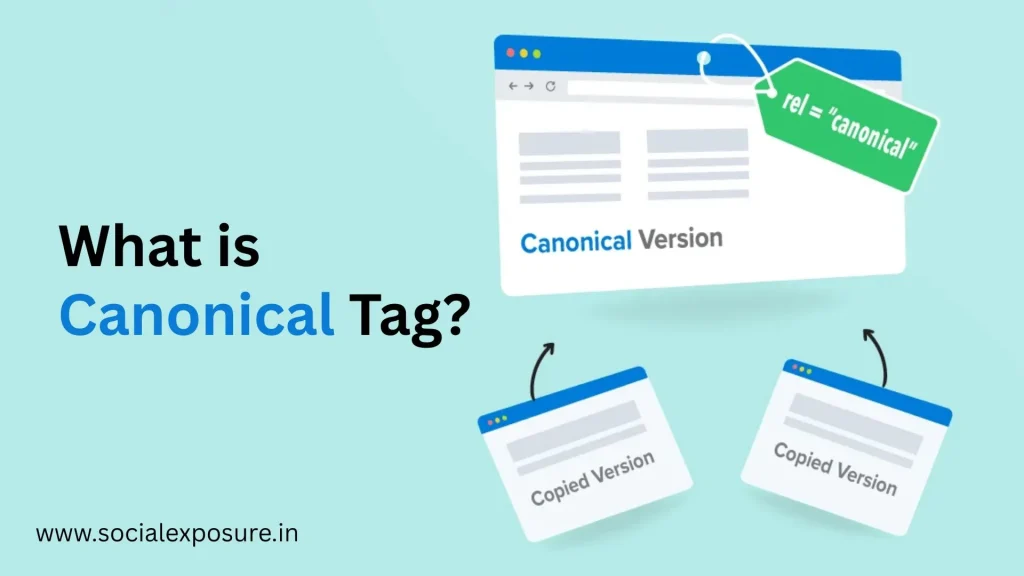Ever felt like your website pages are competing against each other in search results? That might be happening because of a canonical tag you missed or didn’t set up right. This small line of code tells search engines which page should be treated as the original when there are similar or duplicate versions.
It helps protect your site from ranking issues caused by duplicate content, which is a common challenge today, especially for ecommerce stores, blogs, and sites with dynamic pages.
According to Google Search Central, using the canonical tag correctly improves how your pages are indexed and prevents search engines from getting confused about what to show users. As websites become more content-heavy and mobile-focused, managing these signals has never been more important.
In this blog, we’ll walk through what a canonical tag really is, why it matters, when to use it, and how search engines deal with it.
What is a Canonical Tag?
A canonical tag is a simple HTML element used to tell search engines which version of a webpage should be treated as the main one. It helps avoid confusion when multiple pages have similar or identical content.
This tag becomes essential when your website has pages that look alike or carry the same information. Instead of search engines indexing all those versions separately which could hurt your ranking the canonical tag quietly signals which one should be prioritized.
Think of it like pointing to the original copy in a stack of duplicates. If used correctly, it protects your site’s credibility, keeps your content organized, and prevents unnecessary competition between pages that were never meant to compete.
It’s especially useful for managing product filters, print versions, tracking parameters, or syndicated content where URLs differ, but the main message stays the same. In all of these cases, setting a clear canonical url helps preserve page strength and avoid splitting it across duplicates.
Example Tag Format
Here’s how the canonical tag looks inside your page’s HTML:
<link rel=”canonical” href=”https://www.example.com/sample-page” />
Why Do Canonical Tags Matter for SEO?
When a website has more than one version of the same content, search engines might treat each version as a separate page. This creates confusion about which version should appear in search results. A canonical tag steps in to solve that.
For example, imagine an online store with the same product listed under multiple categories. Without a canonical url, search engines might index all those product pages separately. This not only wastes crawl budget but also risks pushing the wrong page higher in results or none at all.
By adding the right canonical tag, you give a clear signal about which version is the main one. It’s like directing search engines to the final draft instead of reviewing every earlier version.
This is especially helpful for:
- E-commerce sites with filterable or sortable product lists
- Pages with tracking parameters in the URL
- Syndicated content published on other domains
- Sites with both www and non-www versions of a page
Consolidating Ranking Signals
Using canonical tags also helps protect your page’s strength. When multiple versions of the same content exist, links pointing to each of those pages can divide the value they pass to your site. The canonical tag helps combine those signals into one.
Let’s say a blog post is shared across several URLs, each with slightly different parameters. Without a canonical url, search engines may treat each one as separate, splitting up the authority from backlinks. That makes it harder for any one version to perform well.
A proper canonical setup allows you to:
- Combine page authority under one preferred URL
- Avoid having similar pages competing against each other
- Preserve your link equity, helping your chosen page rank stronger
For businesses, this helps maintain consistency and protects key landing pages from being sidelined by accidental duplicates. In the end, the canonical tag ensures your strongest content isn’t diluted, scattered, or missed.
When to Use Canonical Tags?
Understanding when to use canonical tags can make a noticeable difference in how your pages are treated by search engines. The goal is to avoid duplicate confusion and keep your most valuable pages in focus.
Here are common situations where a canonical tag helps:
- Product pages with filters or sorting options
If your online store allows users to filter by size, color, or price, the same product might exist under several URLs. A canonical tag should point all filtered versions to the main product page. - Paginated content
Long lists of articles or products spread across pages? Canonical tags can help group them under one key page to avoid dilution. - Syndicated content
If your article is republished on another platform, the canonical tag should point to the original source to maintain credit and ranking. - Print-friendly or mobile-specific URLs
When your site offers alternate layouts for printing or mobile use, a canonical tag ensures the primary version is indexed. - Tracking or referral parameters
URLs with UTM tags or other parameters should point to the clean version using a canonical tag to prevent search engines from treating them as separate pages. - Same content under different categories
Blogs or products placed in multiple categories can create multiple access points. Canonical tags let you signal which one to prioritize.
Choosing the right moments to use canonical tags ensures consistency in search results and strengthens the visibility of your key pages. Tools like Rank Math, Yoast, and other SEO plugins make it easier to manage canonical tags directly within your content editor, especially if you’re using WordPress or Shopify. Social Exposure recommends reviewing your content regularly for unintentional duplicates, especially if you run a product-heavy site or use dynamic URLs.
Common Canonical Tag Issues
Getting the canonical tag right may seem simple, but small errors often create bigger problems than expected. From broken indexing to lost traffic, these issues affect both small websites and large platforms. These situations come up often in audits we do at Social Exposure, especially on content-heavy or e-commerce sites.
Here are the most common types of canonical issues you should look out for:
Missing Canonical Tags
Not using a canonical tag at all can lead to duplicate indexing, especially when your content is accessible through different paths or has URL variations. This confuses search engines, splits authority between pages, and wastes valuable crawl budget.
Example: A blog post accessible at both /blog/post-title and /post-title without any tag to point to the preferred version.
Conflicting Canonical URLs
This happens when different versions of a page point to different canonical destinations, or when your page says it’s canonical but other signals (like redirects or sitemaps) say otherwise.
Search engines rely on consistency. When signals don’t match, it creates uncertainty and may lead to unpredictable indexing or ignored tags.
Self-referencing Issues
While it’s often correct for a page to use a self-referencing canonical url, some platforms fail to generate this properly. Others reference the wrong version, like pointing to an HTTP version instead of HTTPS.
If the tag doesn’t reflect the current, preferred version of the page, search engines may ignore it or choose another version entirely.
Incorrect Implementation
This includes placing the tag in the wrong part of the page, using relative URLs when absolute ones are needed, or dynamically generating different canonical tags depending on session IDs or user actions.
Incorrect syntax or faulty plugin behavior can also result in search engines disregarding the tag completely.
Addressing these problems isn’t just technical cleanup. It helps restore trust in your site’s structure, improves crawl efficiency, and allows your most valuable pages to gain the visibility they deserve.
Canonical Tag vs Canonical URL
It’s common to hear both canonical tag and canonical url used as if they mean the same thing, but they refer to slightly different parts of the process.
The canonical tag is the actual piece of code added to your webpage. It lives in the HTML <head> and points to the preferred version of that page. It’s the signal that tells search engines, “Index this one, not the others.”
The canonical url, on the other hand, is the destination the tag points to. It’s the full link that search engines treat as the original or main version of the page.
To make it clearer:
- The canonical tag is the instruction.
- The canonical url is the target of that instruction.
When both are used correctly, they work together to help search engines index the right page and reduce confusion. This small distinction helps teams avoid miscommunication, especially when working across development, content, and SEO.
How Search Engines Handle Canonical Tags?
When a canonical tag is added to a page, search engines treat it as a suggestion rather than a strict command. Most of the time, if the tag is correctly placed and supported by other signals, it’s respected. But there are situations where Google ignores canonicals, especially if the declared canonical doesn’t align with what it observes across the site.
Search engines look at multiple factors before accepting a canonical declaration:
- The content similarity between the original and alternate pages
- Internal links pointing to each version
- XML sitemaps and hreflang references
- Redirect behavior and page loading structure
- HTTP vs HTTPS consistency
If the declared canonical appears less relevant or less complete than its duplicate, the search engine may choose a different page to index. That’s why relying only on the tag, without supporting signals, can lead to inconsistent indexing.
For teams working on large websites, or with duplicate-heavy setups like e-commerce or publishing platforms, this is where it helps to combine proper canonical tagging with broader site audits. Experienced teams like Social Exposure often spot these mismatches early during technical evaluations, especially when multiple indexing signals contradict the canonical declaration.
Do Canonical Tags Affect Rankings?
A common question is, does canonical tag affect rankings directly? The answer is no in the strict sense, but yes in how it shapes the foundation for ranking.
Here’s how:
- Canonical tags consolidate link equity by grouping duplicate pages under one URL
- They reduce duplicate indexing, which helps search engines better understand content purpose
- They protect primary pages from competing with near-identical versions
- They improve overall indexing control, allowing faster and more accurate crawling
So, while you won’t rank higher just by adding a tag, getting it right strengthens the visibility of the content you want to be found.
Conclusion
If you’re serious about keeping your website clear, consistent, and easy for search engines to understand, learning how to use the canonical tag is a smart move. It’s one of those quiet tools that keeps things in order behind the scenes, protecting your pages from duplicate confusion and lost traffic.
The better you manage canonical tags, the more control you gain over how your content is seen and ranked. It’s not just about avoiding mistakes, it’s about giving your top pages the space they deserve to stand out.
To avoid costly SEO mistakes, work with a Best SEO Agency like Social Exposure, which understands how to get the details right and guide your strategy effectively.
Frequently Asked Questions
What is a canonical tag in SEO?
A canonical tag is an HTML signal that tells search engines which version of a webpage should be treated as the main one when similar or duplicate pages exist. It helps prevent duplicate content issues and improves indexing accuracy.
Why are canonical tags important?
They help consolidate similar pages, preserve ranking strength, and avoid confusion in search results. Without them, search engines might index the wrong page or spread link value across duplicates.
What is the difference between canonical and 301 redirects?
A canonical tag suggests which page to index while keeping all versions live. A 301 redirect permanently sends users and search engines to a different URL, removing the original from visibility.
How does Google handle canonical tags?
Google treats canonical tags as a strong hint. If the tag aligns with other signals like internal links, sitemaps, and content match, it’s usually respected. Otherwise, Google may choose a different canonical page.
What happens if a canonical tag is missing?
Without a tag, search engines may index multiple versions of the same content. This can lead to canonical issues, such as duplicate indexing or diluted link authority across similar URLs.
Can I use multiple canonical tags?
No, each page should have only one canonical tag. Multiple tags cause confusion and can be ignored entirely by search engines.
Should every page have a canonical tag?
Yes, even if the page is unique. A self-referencing canonical url helps confirm the page as its own preferred version and keeps your site structure clear.
What is a canonical issue?
It refers to problems like missing tags, conflicting URLs, incorrect syntax, or duplicate pages without a clear preference. These can affect crawl efficiency and indexing accuracy.
Is a canonical tag mandatory?
It is not essential, but highly encouraged. As stated by Social Exposure, adopting it on a regular basis provides your site greater authority over how search engines understand your content.
What is the best way to manage duplicate content using canonical tags?
Point each variation of a duplicate page to one preferred canonical url using an HTML tag placed in the <head> section. This ensures authority and indexing stay focused on the right version.






